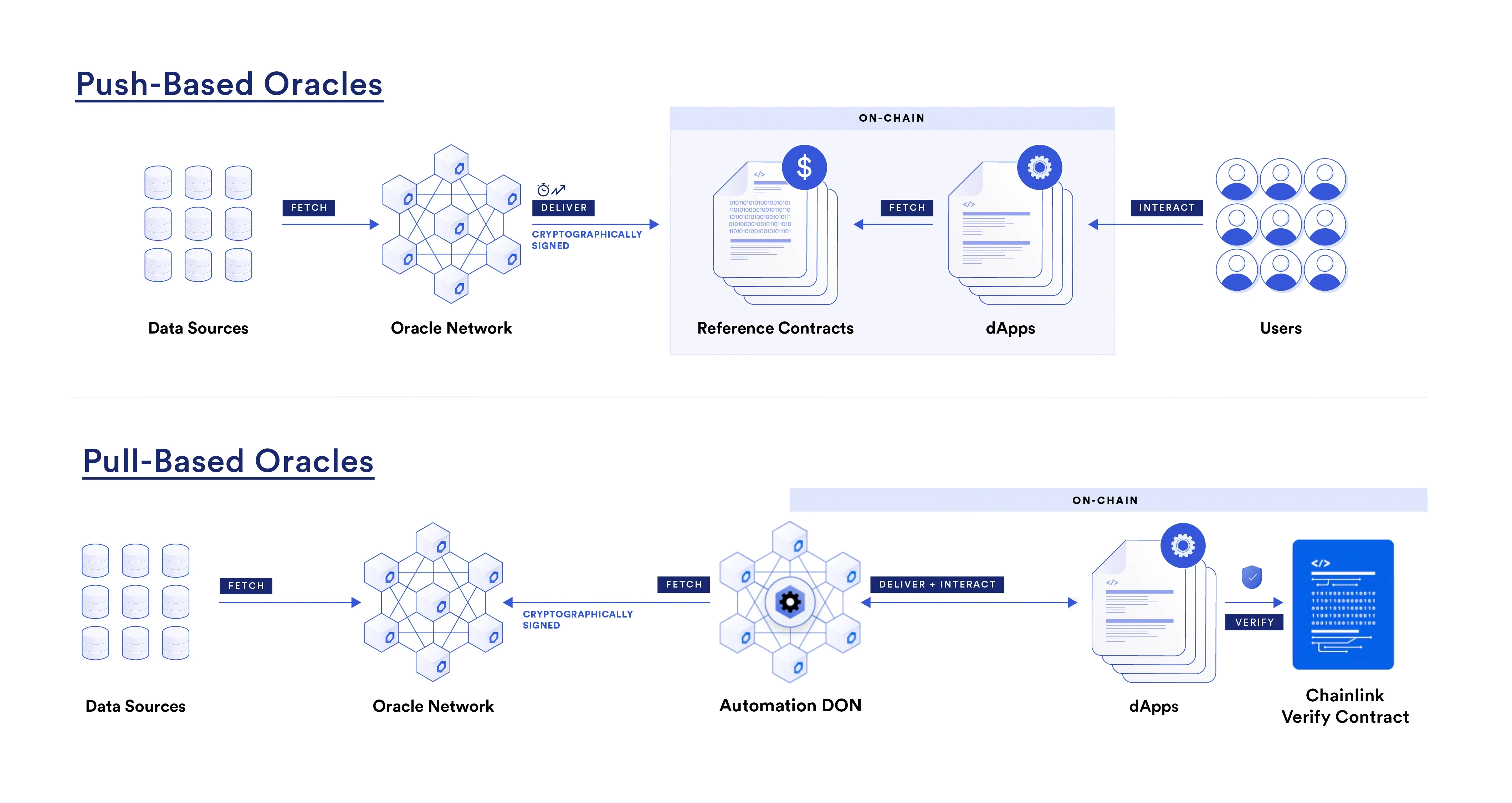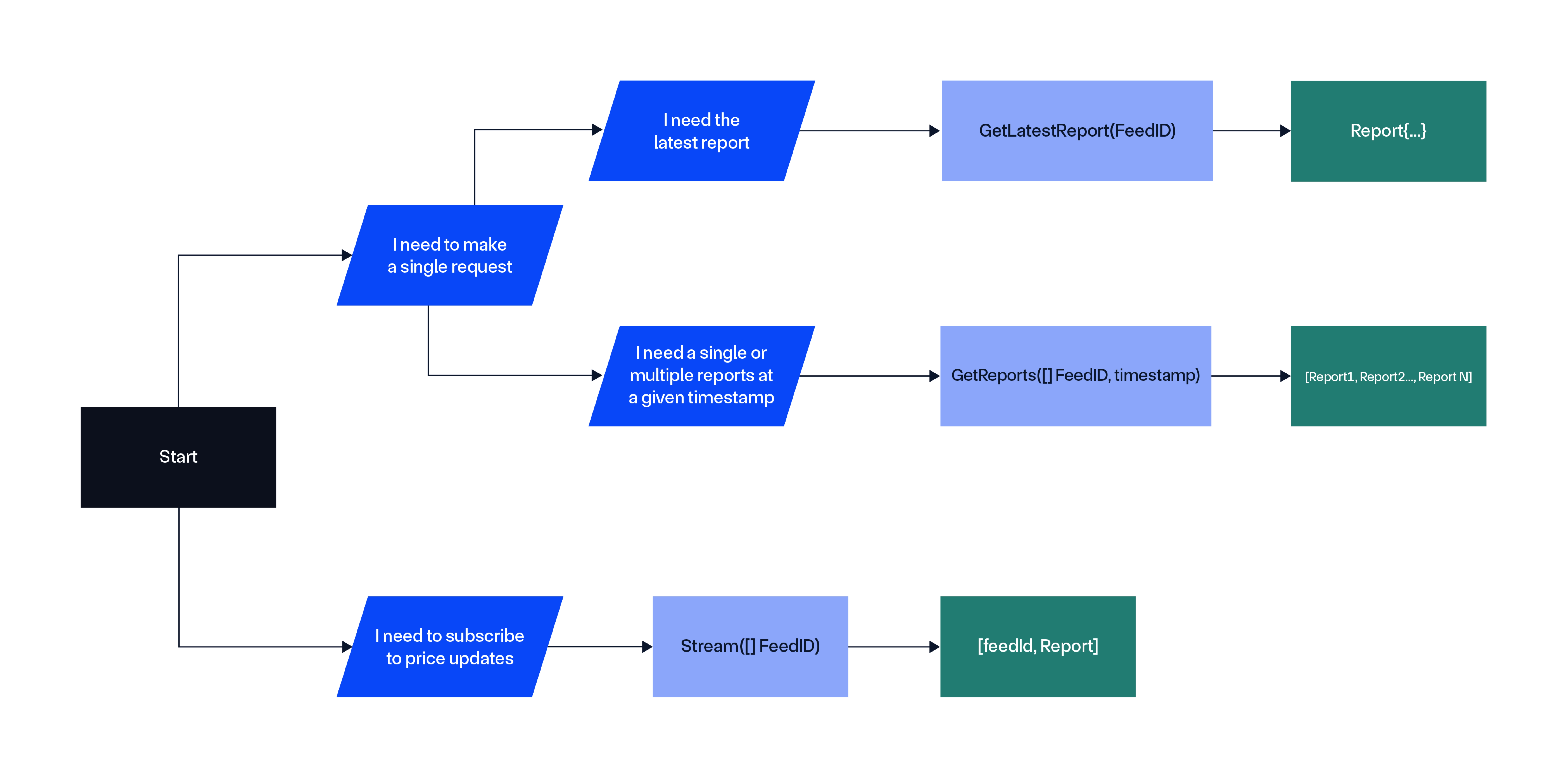Chainlink Data Streams
Chainlink Data Streams delivers low-latency market data offchain, which you can verify onchain. This approach provides decentralized applications (dApps) with on-demand access to high-frequency market data backed by decentralized, fault-tolerant, and transparent infrastructure.
Traditional push-based oracles update onchain data at set intervals or when certain price thresholds are met. In contrast, Chainlink Data Streams uses a pull-based design that preserves trust-minimization with onchain verification.
Sub-Second Data and Commit-and-Reveal
Chainlink Data Streams supports sub-second data resolution for latency-sensitive use cases by retrieving data only when needed. You can combine the data with any transaction in near real time. A "commit-and-reveal" approach mitigates frontrunning by making trade data and stream data visible atomically onchain.
Comparison to push-based oracles
Chainlink's push-based oracles regularly publish price data onchain. By contrast, Chainlink Data Streams relies on a pull-based design, letting you retrieve a report and verify it onchain whenever you need it. Verification confirms that the decentralized oracle network (DON) agreed on and signed the data. Some applications only need onchain data at fixed intervals, which suits push-based oracles. However, others require higher-frequency updates and lower latency. Pull-based oracles meet these needs and still provide cryptographic guarantees about data accuracy.

Push-based and pull-based oracles comparison
Pull-based oracles also operate more efficiently by retrieving data only when necessary. For example, a decentralized exchange might fetch a Data Streams report and verify it onchain only when a user executes a trade, rather than continuously pushing updates that might not be immediately used.
Comprehensive market insights
Chainlink Data Streams offers price points such as mid prices and Liquidity-Weighted Bid and Ask (LWBA) for Crypto Streams. LWBA prices reflect current order book conditions, providing deeper insight into market liquidity and depth. With additional parameters, such as volatility and liquidity metrics, Data Streams helps protocols enhance trading accuracy, improve onchain risk management, and dynamically adjust margins or settlement conditions in response to real-time market shifts.
High availability and resilient infrastructure
Data Streams API services use an active-active multi-site deployment model across multiple distributed and isolated origins. This architecture ensures continuous operations even if one origin fails, delivering robust fault tolerance and high availability.
Example use cases
Access to low-latency, high-frequency data enables a variety of onchain applications:
- Perpetual Futures: Sub-second data and frontrunning mitigation allow onchain perpetual futures protocols to compete with centralized exchanges on performance while retaining transparency and decentralization.
- Options: Pull-based oracles provide timely settlement of options contracts with the added benefit of market liquidity data to support dynamic onchain risk management.
- Prediction Markets: High-frequency updates let participants act on real-time data, ensuring quick reactions to events and accurate settlement.
Key capabilities
- Sub-second Latency: Pull data on-demand with minimal delay
- Cryptographic Verification: Verify data authenticity onchain when needed
- Multiple Access Methods: REST API, WebSocket, or SDK integration
- Comprehensive Market Data: Mid prices, LWBA prices, volatility, and liquidity metrics
- High Availability: Multi-site deployment ensures 99.9%+ uptime
How to use Data Streams
You can access Chainlink Data Streams through SDKs and APIs, allowing you to build custom solutions with low-latency, high-frequency data. Fetch reports or subscribe to report updates from the Data Streams Aggregation Network and verify their authenticity onchain.

Chainlink Data Streams - On-Demand Offchain Workflows
Integration options
Access data directly through REST APIs or WebSocket connections using our SDKs:
- Go SDK - Full-featured SDK with comprehensive examples
- Rust SDK - High-performance SDK for Rust applications
- REST API or WebSocket - Direct access to Data Streams endpoints
Getting started
-
Understand the Architecture: Review the system components and data flow to understand how Data Streams works.
-
Explore Available Data: Browse available Stream IDs and report schemas to see what data is available.
-
Try the API: Follow our hands-on tutorial to fetch and decode your first report.
-
Implement Verification: Add onchain verification to ensure data authenticity in your smart contracts.
Streams Trade: An alternative implementation
For applications that require automated data retrieval and execution, Streams Trade combines Chainlink Data Streams with Chainlink Automation to deliver automated trade execution with frontrunning mitigation. This approach suits dApps that require automated, trust-minimized trade execution and high-frequency market data.